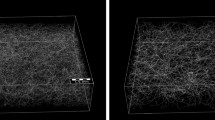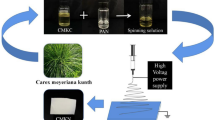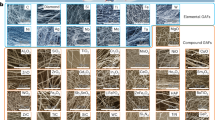Abstract
An attempt to analyze the pore structure of the cuprammonium regenerated cellulose hollow fiber (BMM hollow fiber) in order to clear up its filtration mechanism was made. The electron microscopy was employed to get the concrete images of the structure. The cellulose particles of rod-like shape with circular cross section having mean diameter of about 50 nm were its constructing units. The pores were classified into two types, i.e., the pore with the average diameter of about 50 nm and another with the diameter of several hundreds to several thousands nm. The former was estimated to be the capillary formed among neighboring cellulose particles and the latter to be the void formed as a vacant space which was originated by the phase separation as polymer lean phase. The frequency distribution curve of the void size showed several peaks indicating the occurrence of the boundary breakage between voids originated by the elongation of the fiber in the spinning process. The performances of BMM depends mainly on the existence of capillaries, then BMM with higher ability may be obtained by means of the spinning method which can decrease the occurrence of structure breakage due to the elongation during spinning.
Similar content being viewed by others
Log in or create a free account to read this content
Gain free access to this article, as well as selected content from this journal and more on nature.com
or
References
K. Okuyama, Y. Fukushima, Y. Miura, R. Honma, S. Manabe, G. Ishikawa, M. Satani, and K. Komuro, J. J. Clinical Hematology, 29, 662 (1988).
Y. Hamamoto, S. Harada, S. Kobayashi, K. Yamaguchi, H. Iijima, S. Manabe, T. Tsurumi, H. Aizawa, and N. Yamamoto, Vox Sang., 56, 230 (1989).
S. Manabe. T. Tsurumi, G. Ishikawa, M. Satani, T. Yamashiki, Y. Hamamoto, K. Yamaguchi, S. Kobayashi, and N. Yamamoto, Membrane, 14(1), 77 (1989).
S. Sekiguchi, K. Ito, M. Kobayashi, H. Ikeda, T. Tsurumi, G. Ishikawa, S. Manabe, M. Satami, and T. Yamashiki, Membrane, 14(4), 101 (1989).
T. Tsurumi, N. Osawa, T. Hirasaki, K. Yamaguchi, S. Manabe, and T. Yamashiki, Polym. J., 22, 304 (1990).
S. Manabe, M. Iwata, and M. Inoue, Japanese Patent Application, 58-89625 (1983).
M. Iwata, S. Manabe, and M. Inoue, Japanese Patent Application, 59-204911 (1984).
K. Kamide and S. Manabe “Matenals Science of Synthetic Membranes,” D. R. Lloyd, Ed., American Chemical Society, Washington, D.C., 1985, p 197.
S. Manabe, Y. Kamata, H. Iijima, and K. Kamide, Polym. J., 19, 319 (1987).
Author information
Authors and Affiliations
Rights and permissions
About this article
Cite this article
Tsurumi, T., Osawa, N., Hitaka, H. et al. Structure of Cuprammonium Regenerated Cellulose Hollow Fiber (BMM Hollow Fiber) for Virus Removal. Polym J 22, 751–758 (1990). https://doi.org/10.1295/polymj.22.751
Issue date:
DOI: https://doi.org/10.1295/polymj.22.751
Keywords
This article is cited by
-
Filter made of cuprammonium regenerated cellulose for virus removal: a mini-review
Cellulose (2022)
-
Cellulose-based virus-retentive filters: a review
Reviews in Environmental Science and Bio/Technology (2017)
-
Improved removal of viruslike particles from purified monoclonal antibody IgM preparation via virus filtration
Nature Biotechnology (1996)
-
Concentration of live retrovirus with a regenerated cellulose hollow fiber, BMM
Archives of Virology (1994)



